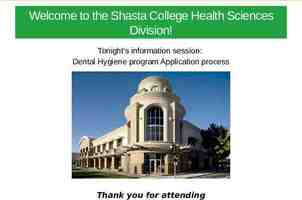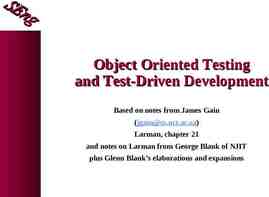Performance ICS 233 Computer Architecture and Assembly Language
28 Slides194.89 KB
Performance ICS 233 Computer Architecture and Assembly Language Dr. Aiman El-Maleh College of Computer Sciences and Engineering King Fahd University of Petroleum and Minerals [Adapted from slides of Dr. M. Mudawar, ICS 233, KFUPM]
Outline Response Time and Throughput Performance and Execution Time Clock Cycles Per Instruction (CPI) MIPS as a Performance Measure Amdahl’s Law Benchmarks Performance and Power Performance ICS 233 – KFUPM Muhamed Mudawar slide 2
What is Performance? How can we make intelligent choices about computers? Why some computer hardware performs better at some programs, but performs less at other programs? How do we measure the performance of a computer? What factors are hardware related? software related? How does machine’s instruction set affect performance? Understanding performance is key to understanding underlying organizational motivation Performance ICS 233 – KFUPM Muhamed Mudawar slide 3
Response Time and Throughput Response Time Time between start and completion of a task, as observed by end user Response Time CPU Time Waiting Time (I/O, OS scheduling, etc.) Throughput Number of tasks the machine can run in a given period of time Decreasing execution time improves throughput Example: using a faster version of a processor Less time to run a task more tasks can be executed Increasing throughput can also improve response time Example: increasing number of processors in a multiprocessor More tasks can be executed in parallel Execution time of individual sequential tasks is not changed But less waiting time in scheduling queue reduces response time Performance ICS 233 – KFUPM Muhamed Mudawar slide 4
Book’s Definition of Performance For some program running on machine X PerformanceX 1 Execution timeX X is n times faster than Y PerformanceX Execution timeY Execution timeX PerformanceY Performance ICS 233 – KFUPM Muhamed Mudawar slide 5 n
What do we mean by Execution Time? Real Elapsed Time Counts everything: Waiting time, Input/output, disk access, OS scheduling, etc. Useful number, but often not good for comparison purposes Our Focus: CPU Execution Time Time spent while executing the program instructions Doesn't count the waiting time for I/O or OS scheduling Can be measured in seconds, or Can be related to number of CPU clock cycles Performance ICS 233 – KFUPM Muhamed Mudawar slide 6
Clock Cycles Clock cycle Clock period 1 / Clock rate Cycle 1 Cycle 2 Cycle 3 Clock rate Clock frequency Cycles per second 1 Hz 1 cycle/sec 1 KHz 103 cycles/sec 1 MHz 106 cycles/sec 1 GHz 109 cycles/sec 2 GHz clock has a cycle time 1/(2 109) 0.5 nanosecond (ns) We often use clock cycles to report CPU execution time CPU Execution Time CPU cycles cycle time Performance ICS 233 – KFUPM Muhamed Mudawar slide 7 CPU cycles Clock rate
Improving Performance To improve performance, we need to Reduce number of clock cycles required by a program, or Reduce clock cycle time (increase the clock rate) Example: A program runs in 10 seconds on computer X with 2 GHz clock What is the number of CPU cycles on computer X ? We want to design computer Y to run same program in 6 seconds But computer Y requires 10% more cycles to execute program What is the clock rate for computer Y ? Solution: CPU cycles on computer X 10 sec 2 109 cycles/s 20 109 CPU cycles on computer Y 1.1 20 109 22 109 cycles Clock rate for computer Y 22 109 cycles / 6 sec 3.67 GHz Performance ICS 233 – KFUPM Muhamed Mudawar slide 8
Clock Cycles Per Instruction (CPI) Instructions take different number of cycles to execute Multiplication takes more time than addition Floating point operations take longer than integer ones Accessing memory takes more time than accessing registers CPI is an average number of clock cycles per instruction I1 1 I2 2 3 I3 4 5 Important point 6 I4 I5 7 8 9 I6 10 CPI 14/7 2 I7 11 12 13 14 cycles Changing the cycle time often changes the number of cycles required for various instructions (more later) Performance ICS 233 – KFUPM Muhamed Mudawar slide 9
Performance Equation To execute, a given program will require Some number of machine instructions Some number of clock cycles Some number of seconds We can relate CPU clock cycles to instruction count CPU cycles Instruction Count CPI Performance Equation: (related to instruction count) Time Instruction Count CPI cycle time Performance ICS 233 – KFUPM Muhamed Mudawar slide 10
Factors Impacting Performance Time Instruction Count CPI cycle time I-Count CPI Program X X Compiler X X ISA X X X X X Organization Technology Performance Cycle X ICS 233 – KFUPM Muhamed Mudawar slide 11
Using the Performance Equation Suppose we have two implementations of the same ISA For a given program Machine A has a clock cycle time of 250 ps and a CPI of 2.2 Machine B has a clock cycle time of 500 ps and a CPI of 1.0 Which machine is faster for this program, and by how much? Solution: Both computers execute same count of instructions I CPU execution time (A) I 2.2 250 ps 550 I ps CPU execution time (B) I 1.0 500 ps 500 I ps Computer B is faster than A by a factor 550 I 1.1 500 I Performance ICS 233 – KFUPM Muhamed Mudawar slide 12
Determining the CPI Different types of instructions have different CPI Let CPIi clocks per instruction for class i of instructions Let Ci instruction count for class i of instructions n (CPI C ) i n CPU cycles (CPI C ) i i i 1 CPI i i 1 n C i i 1 Designers often obtain CPI by a detailed simulation Hardware counters are also used for operational CPUs Performance ICS 233 – KFUPM Muhamed Mudawar slide 13
Example on Determining the CPI Problem A compiler designer is trying to decide between two code sequences for a particular machine. Based on the hardware implementation, there are three different classes of instructions: class A, class B, and class C, and they require one, two, and three cycles per instruction, respectively. The first code sequence has 5 instructions: The second sequence has 6 instructions: 2 of A, 1 of B, and 2 of C 4 of A, 1 of B, and 1 of C Compute the CPU cycles for each sequence. Which sequence is faster? What is the CPI for each sequence? Solution CPU cycles (1st sequence) (2 1) (1 2) (2 3) 2 2 6 10 cycles CPU cycles (2nd sequence) (4 1) (1 2) (1 3) 4 2 3 9 cycles Second sequence is faster, even though it executes one extra instruction CPI (1st sequence) 10/5 2 CPI (2nd sequence) 9/6 1.5 Performance ICS 233 – KFUPM Muhamed Mudawar slide 14
Second Example on CPI Given: instruction mix of a program on a RISC processor What is average CPI? What is the percent of time used by each instruction class? Classi Freqi CPIi CPIi Freqi %Time ALU Load Store Branch 50% 20% 10% 20% 1 5 3 2 0.5 1 0.5 0.2 5 1.0 0.1 3 0.3 0.2 2 0.4 0.5/2.2 23% 1.0/2.2 45% 0.3/2.2 14% 0.4/2.2 18% Average CPI 0.5 1.0 0.3 0.4 2.2 How faster would the machine be if load time is 2 cycles? What if two ALU instructions could be executed at once? Performance ICS 233 – KFUPM Muhamed Mudawar slide 15
MIPS as a Performance Measure MIPS: Millions Instructions Per Second Sometimes used as performance metric Faster machine larger MIPS MIPS specifies instruction execution rate MIPS Instruction Count Execution Time 10 6 Clock Rate CPI 106 We can also relate execution time to MIPS Execution Time Performance Inst Count MIPS 10 6 ICS 233 – KFUPM Muhamed Mudawar slide 16 Inst Count CPI Clock Rate
Drawbacks of MIPS Three problems using MIPS as a performance metric 1. Does not take into account the capability of instructions Cannot use MIPS to compare computers with different instruction sets because the instruction count will differ 2. MIPS varies between programs on the same computer A computer cannot have a single MIPS rating for all programs 3. MIPS can vary inversely with performance A higher MIPS rating does not always mean better performance Example in next slide shows this anomalous behavior Performance ICS 233 – KFUPM Muhamed Mudawar slide 17
MIPS example Two different compilers are being tested on the same program for a 4 GHz machine with three different classes of instructions: Class A, Class B, and Class C, which require 1, 2, and 3 cycles, respectively. The instruction count produced by the first compiler is 5 billion Class A instructions, 1 billion Class B instructions, and 1 billion Class C instructions. The second compiler produces 10 billion Class A instructions, 1 billion Class B instructions, and 1 billion Class C instructions. Which compiler produces a higher MIPS? Which compiler produces a better execution time? Performance ICS 233 – KFUPM Muhamed Mudawar slide 18
Solution to MIPS Example First, we find the CPU cycles for both compilers CPU cycles (compiler 1) (5 1 1 2 1 3) 109 10 109 CPU cycles (compiler 2) (10 1 1 2 1 3) 109 15 109 Next, we find the execution time for both compilers Execution time (compiler 1) 10 109 cycles / 4 109 Hz 2.5 sec Execution time (compiler 2) 15 109 cycles / 4 109 Hz 3.75 sec Compiler1 generates faster program (less execution time) Now, we compute MIPS rate for both compilers MIPS Instruction Count / (Execution Time 106) MIPS (compiler 1) (5 1 1) 109 / (2.5 106) 2800 MIPS (compiler 2) (10 1 1) 109 / (3.75 106) 3200 So, code from compiler 2 has a higher MIPS rating !!! Performance ICS 233 – KFUPM Muhamed Mudawar slide 19
Amdahl’s Law Amdahl's Law is a measure of Speedup How a computer performs after an enhancement E Relative to how it performed previously Performance with E ExTime before Speedup(E) Performance before ExTime with E Enhancement improves a fraction f of execution time by a factor s and the remaining time is unaffected ExTime with E ExTime before (f /s (1 – f )) Speedup(E) Performance 1 (f /s (1 – f )) ICS 233 – KFUPM Muhamed Mudawar slide 20
Example on Amdahl's Law Suppose a program runs in 100 seconds on a machine, with multiply instruction responsible for 80 seconds of this time. How much do we have to improve the speed of multiplication if we want the program to run 4 times faster? Solution: suppose we improve multiplication by a factor s 25 sec (4 times faster) 80 sec / s 20 sec s 80 / (25 – 20) 80 / 5 16 Improve the speed of multiplication by s 16 times How about making the program 5 times faster? 20 sec ( 5 times faster) 80 sec / s 20 sec s 80 / (20 – 20) Impossible to make 5 times faster! Performance ICS 233 – KFUPM Muhamed Mudawar slide 21
Benchmarks Performance best obtained by running a real application Use programs typical of expected workload Representatives of expected classes of applications Examples: compilers, editors, scientific applications, graphics, . SPEC (System Performance Evaluation Corporation) Funded and supported by a number of computer vendors Companies have agreed on a set of real programs and inputs Various benchmarks for CPU performance, graphics, high-performance computing, clientserver models, file systems, Web servers, etc. Valuable indicator of performance (and compiler technology) Performance ICS 233 – KFUPM Muhamed Mudawar slide 22
The SPEC CPU2000 Benchmarks 12 Integer benchmarks (C and C ) Name Description 14 FP benchmarks (Fortran 77, 90, and C) Name Description gzip vpr gcc mcf crafty parser eon perlbmk gap vortex bzip2 twolf wupwise swim mgrid applu mesa galgel art equake facerec ammp lucas fma3d sixtrack apsi Compression FPGA placement and routing GNU C compiler Combinatorial optimization Chess program Word processing program Computer visualization Perl application Group theory, interpreter Object-oriented database Compression Place and route simulator Quantum chromodynamics Shallow water model Multigrid solver in 3D potential field Partial differential equation Three-dimensional graphics library Computational fluid dynamics Neural networks image recognition Seismic wave propagation simulation Image recognition of faces Computational chemistry Primality testing Crash simulation using finite elements High-energy nuclear physics Meteorology: pollutant distribution Wall clock time is used as metric Benchmarks measure CPU time, because of little I/O Performance ICS 233 – KFUPM Muhamed Mudawar slide 23
SPEC ratio Execution time is normalized relative to Sun Ultra 5 (300 MHz) SPEC rating Geometric mean of SPEC ratios SPEC 2000 Ratings (Pentium III & 4) Performance 1400 1200 Note the relative positions of the CINT and CFP 2000 curves for the Pentium III & 4 Pentium 4 CFP2000 1000 Pentium 4 CINT2000 800 600 Pe ntium III CINT2000 400 Pentium III CFP2000 200 Pentium III does better at the integer benchmarks, while Pentium 4 does better at the floating-point benchmarks due to its advanced SSE2 instructions 0 500 1000 1500 2000 Clock rate in MHz ICS 233 – KFUPM Muhamed Mudawar slide 24 2500 3000 3500
Performance and Power Power is a key limitation Battery capacity has improved only slightly over time Need to design power-efficient processors Reduce power by Reducing frequency Reducing voltage Putting components to sleep Energy efficiency Important metric for power-limited applications Defined as performance divided by power consumption Performance ICS 233 – KFUPM Muhamed Mudawar slide 25
Performance and Power 1 .6 P e ntiu m M @ 1 .6 /0 .6 G H z P e ntiu m 4 -M @ 2 .4 /1 .2 G H z Relative Performance 1 .4 P e ntiu m III- M @ 1 . 2 /0 .8 G H z 1 .2 1 .0 0 .8 0 .6 0 .4 0 .2 0 .0 S P E C IN T 20 00 S P E C F P20 00 S P E C IN T 2 000 S P E C F P 2000 S P E C IN T 200 0 S P E C FP 2 000 Always on / maximum clock Laptop mode / adaptive clock Benchmark and Power Mode Performance ICS 233 – KFUPM Muhamed Mudawar slide 26 Minimum power / min clock
Relative Energy Efficiency Energy Efficiency Pentium M @ 1.6/0.6 GHz Pentium 4-M @ 2.4/1.2 GHz Pentium III-M @ 1.2/0.8 GHz Energy efficiency of the Pentium M is highest for the SPEC2000 benchmarks SPECINT 2000 SPECFP 2000 SPECINT 2000 SPECFP 2000 Always on / maximum clock Laptop mode / adaptive clock SPECINT 2000 Minimum power / min clock Benchmark and power mode Performance ICS 233 – KFUPM Muhamed Mudawar slide 27 SPECFP 2000
Things to Remember Performance is specific to a particular program Any measure of performance should reflect execution time Total execution time is a consistent summary of performance For a given ISA, performance improvements come from Increases in clock rate (without increasing the CPI) Improvements in processor organization that lower CPI Compiler enhancements that lower CPI and/or instruction count Algorithm/Language choices that affect instruction count Pitfalls (things you should avoid) Using a subset of the performance equation as a metric Expecting improvement of one aspect of a computer to increase performance proportional to the size of improvement Performance ICS 233 – KFUPM Muhamed Mudawar slide 28

































